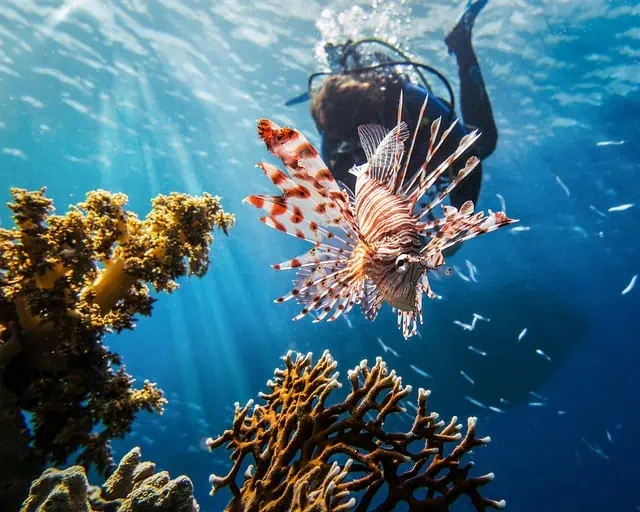Scuba Diving in Costa Rica is very popular with divers around the world as it offers a variety of underwater experiences, from colorful coral reefs to spectacular encounters with pelagic species. Since Costa Rica is bordered by the Caribbean Sea and the Pacific Ocean on both sides of the country, it is possible to go diving tours to the both Pacific and Caribbean Seas during the stay period in Costa Rica. In this post, we review all the Scuba diving spots in Costa Rica that offer an unforgettable experience for both beginners and experienced divers.
Why Should You Choose Scuba Diving in Costa Rica?
- Discover the Breathtaking Dive Sites
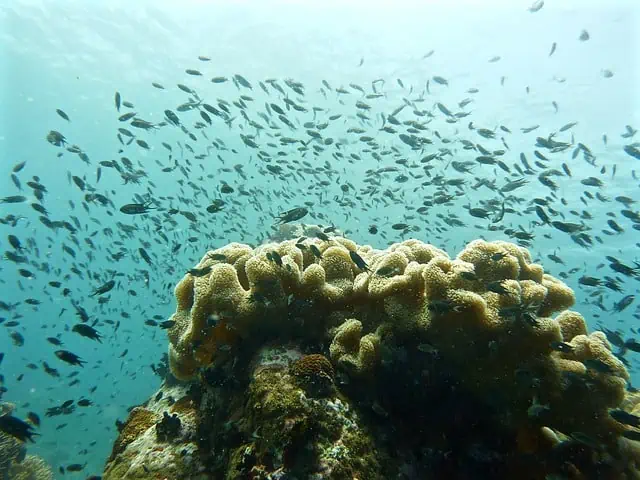
Costa Rica is renowned for its stunning dive sites, each offering a unique and captivating experience. From the lively waters of the Pacific Ocean to the calm Caribbean Sea, there are countless spots to choose from. The Cocos Island, a UNESCO World Heritage Site, boasts dramatic rock formations and an incredible array of marine species, including hammerhead sharks, manta rays, and dolphins. Dive excursions to this remote island are perfect for advanced divers seeking an adrenaline rush.
- Encounter Rich Biodiversity Underwater
Get ready to witness an explosion of life beneath the surface in Costa Rica’s waters. The country’s strategic location between the Pacific and Caribbean means divers can encounter a remarkable diversity of marine species. Schooling fish, colorful coral reefs, sea turtles, and exotic creatures like seahorses and frogfish are just a glimpse of what awaits you. Whether diving in the Bat Islands, Catalina Islands, or Caño Island Biological Reserve, prepare to be amazed by the sheer abundance of underwater life.
- Dive into Cultural Immersion
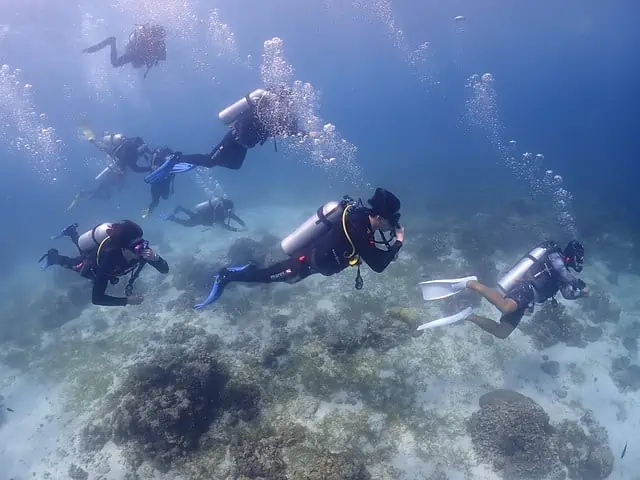
Scuba diving in Costa Rica not only brings you closer to nature but also allows you to immerse yourself in the country’s vibrant culture. After a day of diving, relax on pristine beaches, visit local fishing villages, and savor mouthwatering seafood cuisine. Engage with welcoming locals and learn about their traditions and way of life. With its warm hospitality and rich cultural heritage, Costa Rica offers an experience that goes beyond diving.
- Perfect Dive Conditions All Year Round
One of the reasons Costa Rica is a magnet for scuba divers is its favorable diving conditions throughout the year. With warm waters averaging 75-85°F (24-29°C) and excellent visibility up to 80 feet (24 meters), divers can enjoy their underwater adventures comfortably. The country’s two coastlines offer different experiences, allowing divers to choose the conditions that suit them best. The Caribbean Sea offers calm waters and easy dives, while the Pacific Ocean provides thrilling drift dives and encounters with larger marine species.
- Unearth Extraordinary Underwater Landscapes
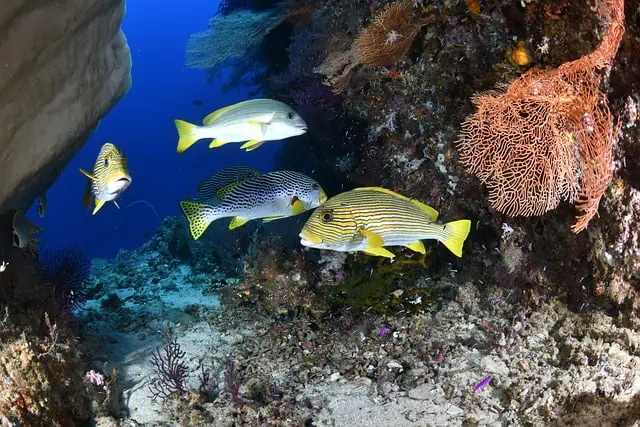
Costa Rica’s underwater world is not only teeming with wildlife but also boasts awe-inspiring landscapes. Plunge into the volcanic waters of the Guanacaste region, where you’ll find craggy rock formations, underwater caves, and breathtaking swim-throughs. Explore the Bat Islands with their dramatic underwater pinnacles and fascinating lava tubes. These unique geological features create an otherworldly environment that will leave you in awe of nature’s creations.
Suggested Read – Snorkeling In Costa Rica
Best Scuba Diving Spots In Costa Rica
Diving Spots on the Pacific Coast.
Cocos Island
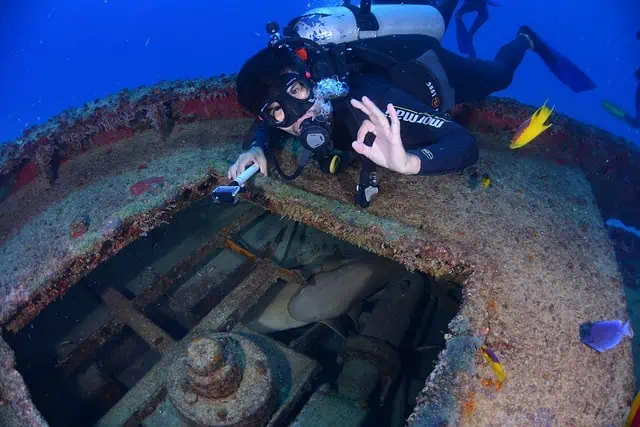
Located 550 kilometers off the Pacific coast of Costa Rica, Cocos Island is a UNESCO World Heritage Site. This remote oasis has attracted experienced divers worldwide with the promise of hammerhead shark encounters, manta rays, and impressive underwater seascapes. Planning a diving trip to Cocos Island takes a lot of meticulous preparation and is a once-in-a-lifetime experience, so the rewards are high too.
Guanacaste
Bat Islands
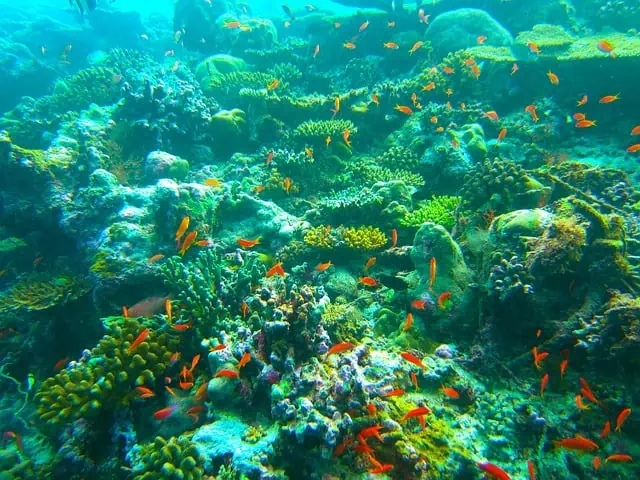
The Bat Islands are a world-class dive site protected by the Costa Rican government. The islands are located north of Country and border the Santa Rosa National Park. The Bat Islands are one of the only spots where you can Scuba diving in Costa Rica with bull sharks. Because of the protected status and remote location, this area is absolutely teeming with marine life. At some dive sites on the island, you can see manta rays as well as various rays, sharks, turtles, eels, and too many species of fish to mention one by one.
Catalina Islands
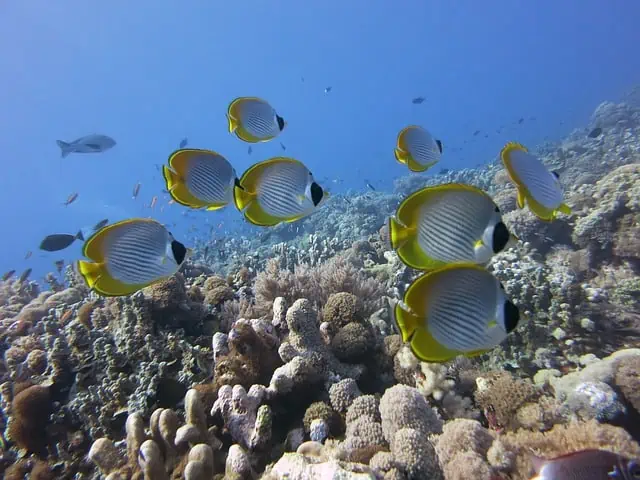
Catalinas gives you the best chance to swim with Pacific giant mantas. The island is home to large fish, rays, and other marine life, and the big reward of diving there is the chance to swim with Pacific giant mantas.
Visibility in the Catalinas is year-round, however, the best visibility is often found from May to mid-November. Whale sharks and orca whales are also occasionally sighted in the area, and humpback whales and dolphins are common.
Tamarindo
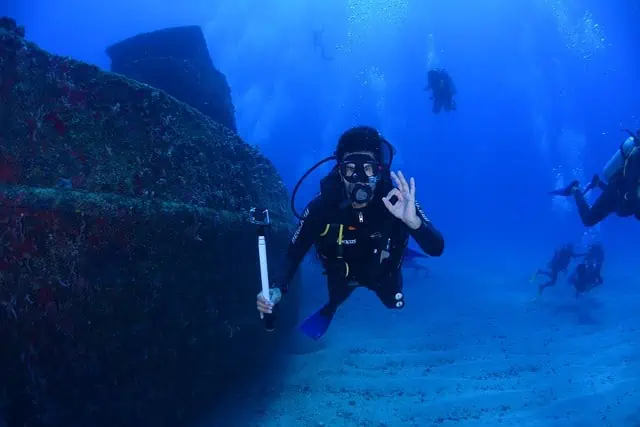
One of the most well-liked beach towns in Costa Rica is Tamarindo, which was formerly a fishing village. These days, tourism is its primary source of revenue. Tamarindo offers a wide range of activities, including zip-lining, horseback riding, kayaking, surfing, ATV trips, hiking, canoeing, diving, and snorkeling. Thousands of visitors travel to Costa Rica annually for its stunning beaches. Several PADI diving shops in Tamarindo provide local dive excursions.
Playas del Coco
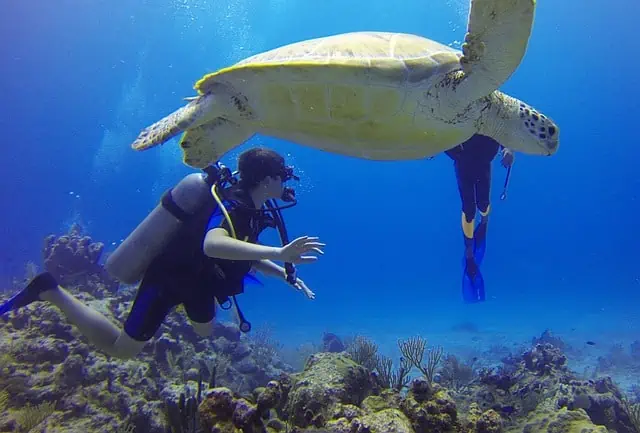
Playas del Coco is a beautiful beach located in Papagayo Bay on the Pacific Ocean and the calmness of the water makes this a beach area with good visibility for scuba diving. Around 20 dive sites can be found around Cocos Beach and, Punta Argentina, Tortuga, and La Cruz are some of them.
Because the water is rich in nutrients, it is common to find a wide variety of marine life including whiptail stingrays, whitetip reef sharks, and large schools of grunts and snappers that have chosen this beach as their home. The weather here is good for diving conditions all year round and offers good visibility.
Playa Hermosa
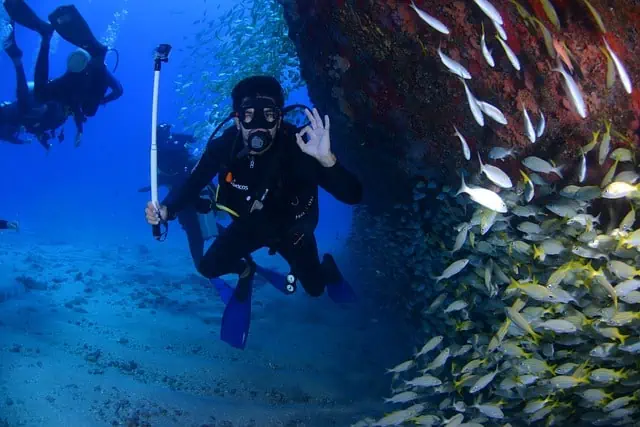
Playa Hermosa, Spanish for beautiful beach, is a quiet, white-sand beach between two mountains. It is located in Papagayo Bay next to Coco Beach and the beach is perceived by tourists as a quiet and comfortable place where you can see a wonderful sunset.
If you are a nature lover, you can also visit Rincon de la Vieja National Park, Palo Verde National Park, and Santa Rosa National Parks located near Playa Hermosa. Diving in Playa Hermosa is a great experience and most of the dive sites are located near Papagayo Bay and Culebra Bay.
More top scuba diving spots in Costa Rica near Playa Hermosa:
- Punta Cacique
- Playa penco
- La Cruz
- Monkey heads
- Punta Balena
- Meros (Culebra Bay)
Herradura
Playa Herradura is a very popular tourist destination. Its black sand beaches have attracted many tourists, many of whom are Sand, Sea, and surfing enthusiasts. Canopy tours in the area and hiking in nearby national parks are popular things to do in Playa Herradura. While Herradura is a great place for beginners who wish to take certification courses for Scuba Diving in Costa Rica, the visibility in this area is quite poor and the marine life is not as abundant as in other places, but you can still see colorful fish, lobsters, moray eels and sometimes a small octopus.
Caño Island
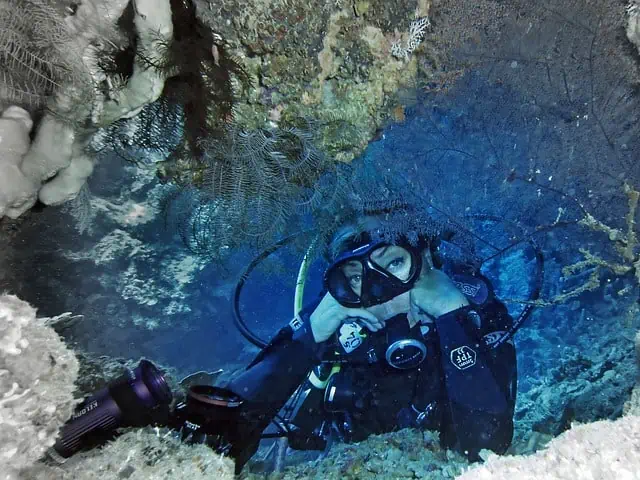
Cano Island is the second-best diving location in Costa Rica after Cocos Island. Many divers call it “Little Cocos Island” because of its beauty and priceless ecosystem. so it’s not incorrect because It protects more than 70 local marine species, 3,24 hectares of woodland, and 5,660 hectares of underwater forest. Due to the Pacific Ocean’s current system, highly migratory animals such as turtles, whales, and humpback whales can be observed all around the island throughout their respective seasons.
Uvita, Marino Ballena
Marino Ballena National Park protects the largest coral reef in Central America and more than 80 marine species inhabit its waters. This is an excellent spot for those interested in scuba diving in Costa Rica. A dive trip in the park offers a great variety of marine life, with goldfish, moray eels, and all types of mollusks and arthropods prominently seen. Between August and October, you can see humpback whales and other cetaceans if you are lucky. However, the best time for a diving trip in the marine park is from December to May and excellent visibility can be guaranteed.
Diving Spots on the Caribbean Coast.
Puerto Viejo
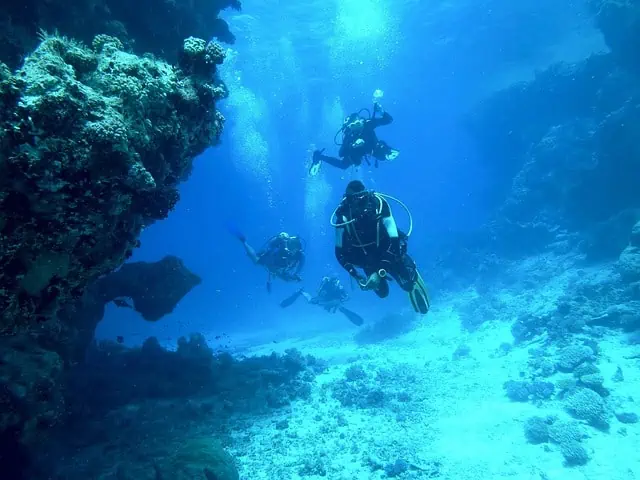
Puerto Viejo is one of the few areas on the Caribbean side of Costa Rica where you can experience good scuba diving. The main attraction here is the natural barrier reef that stretches 50 miles from Puerto Viejo to Panama, and a large part of this coral reef remains unexplored.
Isla Uvita
The shipwrecked Phoenix many years ago has become a coral reef and is home to many marine species in the vicinity of the island of Uvita, which along with another shipwreck has become a valuable diving destination. Divers can find tropical fish, eels, hawks, and an abundance of hard and soft corals in the waters around the island.
Scuba Diving in Costa Rica For Beginners
If you are new to scuba diving there are opportunities in Costa Rica to get your diving skills certified with world-renowned training. Here you will be awarded certificates along with training. Let’s take a quick look at what training and certifications you can get to scuba dive in Costa Rica as a beginner.
- Open Water Diver
Entry-level certification allowing you to dive independently with a buddy
Covers basic dive theory, equipment usage, and safety procedures
Typically requires completing classroom sessions, confined water dives, and open water dives
- Advanced Open Water Diver
Builds upon the skills learned in the Open Water Diver course
Offers specialized training in navigation, deep diving, and other elective dives
Provides opportunities to explore different dive environments and gain experience
- Rescue Diver
Focuses on developing rescue skills and emergency management techniques
Enhances your ability to prevent and respond to diving emergencies
Recommended for divers looking to improve their confidence and preparedness underwater
- Divemaster and Beyond
The first professional level in recreational diving
Prepares individuals to assist instructors and lead certified divers
Serves as a stepping stone towards becoming a dive instructor
Best Schools To Start Scuba Diving In Costa Rica For Beginners
Several world-renowned diving schools and training institutes that offer the above certificates have their offices in Costa Rica. Let’s explore such institutions that can add value and new dimensions to your diving skills.
- PADI (Professional Association of Diving Instructors)
- One of the most recognized dive certification agencies worldwide
- Offers a comprehensive range of courses from beginner to professional levels
- Many dive centers in Costa Rica are affiliated with PADI
More Details– Padi Diving Centers In Costa Rica
- SSI (Scuba Schools International)
- Provides flexible and accessible dive training programs
- Offers digital learning options and e-certifications
- An increasingly popular choice for divers seeking a modern approach to training
More Details – SSI Diving Centers In Costa Rica
Must-Have Diving Gear For Costa Rican Waters
The right equipment is essential for starting an adventure of Scuba diving in Costa Rica. So let’s take a brief look at what are the must-have diving gear.
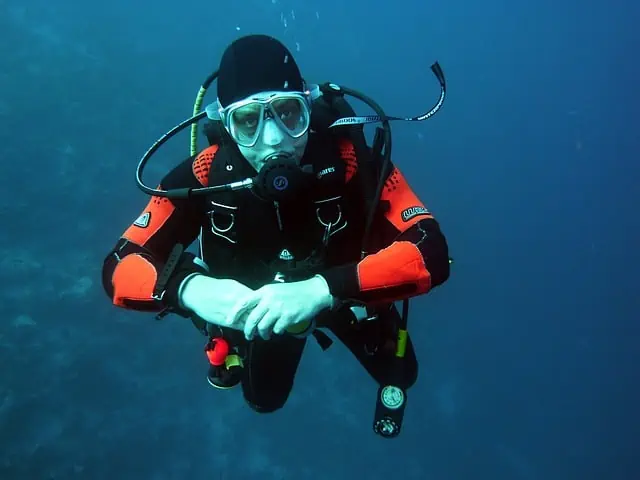
- Mask: A mask that provides a snug fit and wide field of vision with low volume for easy conditioning and minimal fogging.
- Snorkel: A snorkel with a dry, easy-to-clean comfortable mouthpiece and clean valve to prevent water ingress during surface swimming.
- Fins: Versatility and easy-to-use fins with an open heel with adjustable straps
- Wetsuit: Full-length wetsuits of appropriate thickness for water temperature. This protects you from bites, scratches, and UV exposure
- Rash Guard: A lightweight and quick-dry rash guard that protects you from the sun and helps prevent itchiness
- BCD (Buoyancy Control Device): Appropriate for your body size and diving conditions, with adequate lift capacity and Integrated weight pockets for streamlined buoyancy control.
- Regulator: A reliable regulator with a balanced second stage for smooth breathing
- Dive Computer: A computer with a user-friendly interface and customizable features is essential for monitoring dive profiles, depth, time, and decompression limits.
- Dive Knife or Cutting Tool: A knife made of corrosion-resistant material such as titanium or stainless steel for cutting fishing lines, nets, or vegetation in emergencies.
- Dive Light: A durable waterproof light with adjustable brightness settings for dark holes, caves, and night diving.
- Surface Marker Buoy (SMB): A self-inflating SMB to signal your position to surface boats and other divers, and a whistle or air horn to attract attention in emergencies
- Dive Flag: A dive flag for displaying on the surface to warn boats of the presence of divers below.
- First Aid Kit: A first aid kit for treating minor injuries and providing basic medical assistance
- Underwater Photography Gear (Optional): A camera with underwater housing with lighting options to capture the beauty of underwater landscapes and marine life.
Conclusion
You now understand that scuba diving in Costa Rica provides extensive underwater experiences, ranging from amazing macro photography to close encounters with sharks. Therefore, it doesn’t matter if you’re a novice or an experienced diver; this paradise of abundant marine life and breathtaking scenery in Central America provides the opportunity for all skill levels to explore the underwater world. So feel free to use this information to assist you organize your vacation to Costa Rica.
FAQ
- Is Costa Rica good for scuba diving?
Yes, Costa Rica is excellent for scuba diving, offering diverse marine ecosystems, rich biodiversity, and a variety of dive sites suitable for divers of all levels.
- Which side of Costa Rica is better diving?
The Caribbean side of Costa Rica, particularly areas like Puerto Viejo and Cahuita, is renowned for its excellent diving opportunities, boasting vibrant coral reefs, abundant marine life, and clear waters.
- Do you need to be certified to scuba dive in Costa Rica?
Yes, it is generally required to be certified to scuba dive in Costa Rica. But most dive operators and dive sites in Costa Rica will not require proof from novice dives and they will provide courses.


